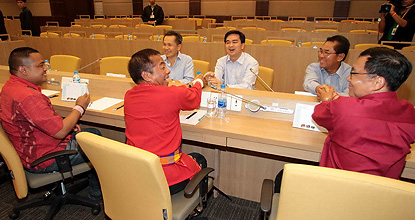Below are some images of the red shirt demonstrations that I snapped on Friday, May 7. I haven’t had a chance to post these photos until now, but I thought they’d be helpful in providing a sense of how things looked at the red shirts’ protest site as of several days ago.
But first, the latest news: The government said today (Wed.) that at midnight tonight, it will cut off water, electricity, phone services, public transportation, and food deliveries to the Rajaprasong area in order to force red shirt protesters to disperse.
Here’s an NYT story with more details. And here’s a story from the BBC, as well as one from Reuters. For some analysis, I suggest checking out this post from BP about the current state of affairs.
On to the images from Friday. As I noted on Twitter at the time ((Yes, I also tweeted a Seh Daeng sighting…)), the red shirt protesters appeared as dug in — and as resolute — as ever. You get the sense, walking around, that — as they’ve shown — they’re there to stay, at least until they get what they (or the red shirt leaders) want.
The protest site, as I’ve told others, resembles a massive tent city. It is a demonstration site, yes. But it is also a village in and of itself. There are facilities for sleeping, bathing, eating, and sanitation. There are red shirt “guards” who control roads leading to and within the site (see image below).
There are tents with TVs and DVD players set up, where footage of the April 10 clashes are played on a loop. There are foot massage services. And in addition to every manner of red shirt merchandise being on sale, there are even mobile phone charging services (see image below).
The bamboo barricade, near Silom, wasn’t heavily manned when I was there; most demonstrators had pulled back several hundred meters away, toward Rajaprasong. Below are several photos; there are a few more in the complete Flickr photoset.


























